- About us
- Support the Gallery
- Venue hire
- Publications
- Research library
- Organisation chart
- Employment
- Contact us
- Make a booking
- Onsite programs
- Online programs
- School visit information
- Learning resources
- Little Darlings
- Professional learning
Ruby Hunter (1955–2010), singer/songwriter, was a Ngarrindjeri/Kukatha/Pitjantjatjara woman from South Australia. At the age of eight she was taken from her family and placed in the Seaforth Children's Home; she later lived with a foster family. At sixteen she met her life partner Archie Roach at a Salvation Army drop-in centre. Hunter released her first album, Thoughts within, in 1994. She won Deadly Awards in 2000 for Female Artist of the Year, 2003 for Outstanding Contribution to Aboriginal and Torres Strait Islander Music and 2004 for Excellence in Film and Theatrical Score. She made her acting debut with a key role in Rachel Perkins' One Night the Moon (2001), starring Paul Kelly. In 2004 Hunter and Roach collaborated with Paul Grabowsky's Australian Art Orchestra on Ruby's Story, which told her life story through song and spoken word. The following year, Hunter was invited by Deborah Conway to take part in the Broad Festival project with Sara Storer, Katie Noonan and Clare Bowditch, performing their own and each other's songs. She worked tirelessly to support and encourage young Aboriginal people, running an open house for teenagers. Hunter, who tragically died of a heart attack at 55, said her most proud achievement was keeping her family – Roach, their two children and three foster children – together as a stable unit.
Purchased 2012
© Jacqueline Mitelman
A photographic portrait of the singer/song writer, Ruby Hunter by Jacqueline Mitelman, created in 1996 and printed in 2012. The image measures 43 cm high by 34 cm wide with a white border on all sides, mounted in a narrow wooden frame. The colour tones range from chalky white to velvety black.
The image depicts Ruby’s softly lit face and shoulders emerging from a dark background, jet black apart from a beam of silvery light above her head on the left. Her shoulders are slightly turned towards her right whilst her face is turned towards us.
Wrapped around her head is a headband woven in the design of the Aboriginal flag, with a black stripe across the top and a grey stripe along the bottom, with a lighter-coloured circle in the centre. Pinned in the middle of the circle is an oval dark stone surrounded by little white beads. Attached further to the right is a brooch, shaped like a leaf with a border of tiny sparkly diamantés.
Ruby’s round face is framed by a mass of dark hair which merges into the black background. Her curly fringe pokes out randomly from under her headband and covers most of her forehead. She has plucked arched eyebrows, obscured by her hair. Her deeply set dark eyes gaze intently at us; stripes of light reflect in her pupils. Smooth plump cheeks and a broad nose with wide symmetrical nostrils are framed by deep crease lines from the outer edges of her nose around the corners of her closed mouth. Although her full lips are drawn slightly downwards, there is a hint of a smile.
Two tightly bound cords capture a small bunch of emu feathers. They hang from beneath her hair on to her shoulders, one on either side of her face. The feathers on her right side are soft and indistinct, slightly out of focus, where the one on her left is sharply in focus – the delicate details of each feather, very apparent. They rest on her chest just below her collarbone. She wears a well-worn cotton collared shirt, lightly creased with the top couple of buttons undone.
Audio description written by Sally Dawson and voiced by Alana Sivell, 2021



On one level The Companion talks about the most famous and frontline Australians, but on another it tells us about ourselves.
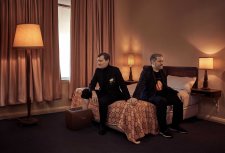
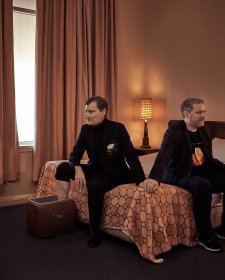
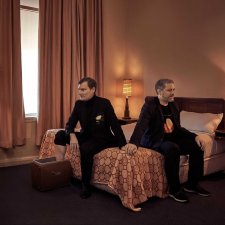
Sandra Bruce gazes on love and the portrait through Australian Love Stories’ multi-faceted prism.
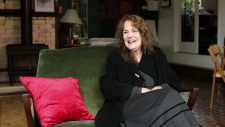
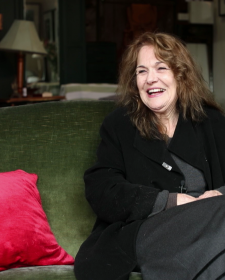

Australian photographer, Jacqueline Mitelman, discusses her process for creating portraiture.